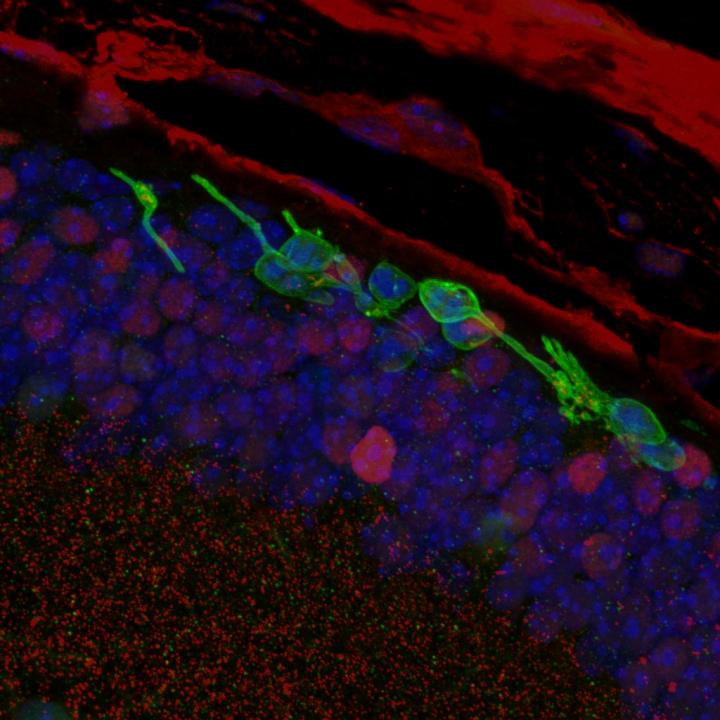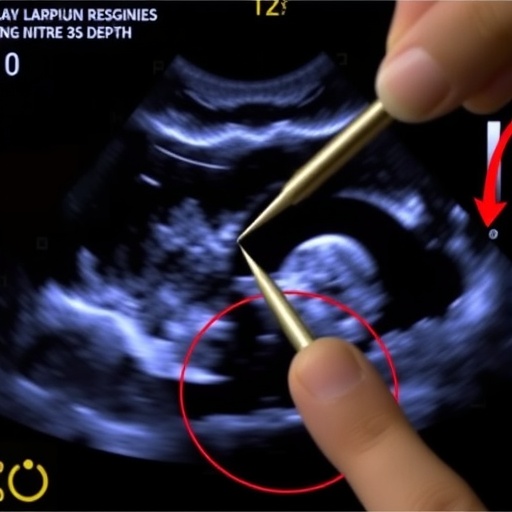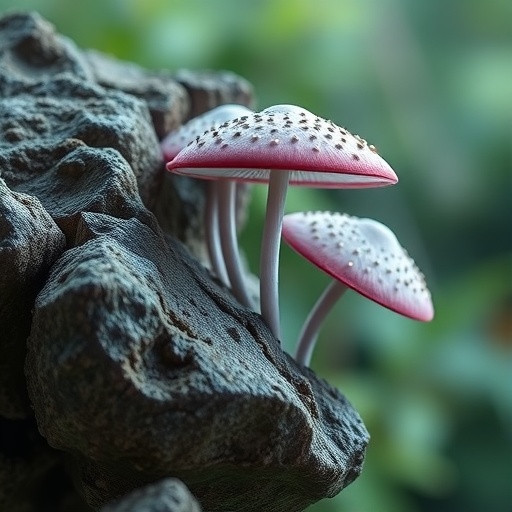NIH-funded study offers new path to modeling eye disease, advancing therapies

Credit: Sai Chavala
Researchers have discovered a technique for directly reprogramming skin cells into light-sensing rod photoreceptors used for vision. The lab-made rods enabled blind mice to detect light after the cells were transplanted into the animals’ eyes. The work, funded by the National Eye Institute (NEI), published April 15 in Nature. The NEI is part of the National Institutes of Health.
Up until now, researchers have replaced dying photoreceptors in animal models by creating stem cells from skin or blood cells, programming those stem cells to become photoreceptors, which are then transplanted into the back of the eye. In the new study, scientists show that it is possible to skip the stem-cell intermediary step and directly reprogram skins cells into photoreceptors for transplantation into the retina.
“This is the first study to show that direct, chemical reprogramming can produce retinal-like cells, which gives us a new and faster strategy for developing therapies for age-related macular degeneration and other retinal disorders caused by the loss of photoreceptors,” said Anand Swaroop, Ph.D., senior investigator in the NEI Neurobiology, Neurodegeneration, and Repair Laboratory, which characterized the reprogrammed rod photoreceptor cells by gene expression analysis.
“Of immediate benefit will be the ability to quickly develop disease models so we can study mechanisms of disease. The new strategy will also help us design better cell replacement approaches,” he said.
Scientists have studied induced pluripotent stem (iPS) cells with intense interest over the past decade. IPSCs are developed in a lab from adult cells –rather than fetal tissue– and can be used to make nearly any type of replacement cell or tissue. But iPS cell reprogramming protocols can take six months before cells or tissues are ready for transplantation. By contrast, the direct reprogramming described in the current study coaxed skin cells into functional photoreceptors ready for transplantation in only 10 days. The researchers demonstrated their technique in mouse eyes, using both mouse- and human-derived skin cells.
“Our technique goes directly from skin cell to photoreceptor without the need for stem cells in between,” said the study’s lead investigator, Sai Chavala, M.D., CEO and president of CIRC Therapeutics and the Center for Retina Innovation. Chavala is also director of retina services at KE Eye Centers of Texas and a professor of surgery at Texas Christian University and University of North Texas Health Science Center (UNTHSC) School of Medicine, Fort Worth.
Direct reprogramming involves bathing the skin cells in a cocktail of five small molecule compounds that together chemically mediate the molecular pathways relevant for rod photoreceptor cell fate. The result are rod photoreceptors that mimic native rods in appearance and function.
The researchers performed gene expression profiling, which showed that the genes expressed by the new cells were similar to those expressed by real rod photoreceptors. At the same time, genes relevant to skin cell function had been downregulated.
The researchers transplanted the cells into mice with retinal degeneration and then tested their pupillary reflexes, which is a measure of photoreceptor function after transplantation. Under low-light conditions, constriction of the pupil is dependent on rod photoreceptor function. Within a month of transplantation, six of 14 (43%) animals showed robust pupil constriction under low light compared to none of the untreated controls.
Moreover, treated mice with pupil constriction were significantly more likely to seek out and spend time in dark spaces compared with treated mice with no pupil response and untreated controls. Preference for dark spaces is a behavior that requires vision and reflects the mouse’s natural tendency to seek out safe, dark locations as opposed to light ones.
“Even mice with severely advanced retinal degeneration, with little chance of having living photoreceptors remaining, responded to transplantation. Such findings suggest that the observed improvements were due to the lab-made photoreceptors rather than to an ancillary effect that supported the health of the host’s existing photoreceptors,” said the study’s first author Biraj Mahato, Ph.D., research scientist, UNTHSC.
Three months after transplantation, immunofluorescence studies confirmed the survival of the lab-made photoreceptors, as well as their synaptic connections to neurons in the inner retina.
Further research is needed to optimize the protocol to increase the number of functional transplanted photoreceptors.
“Importantly, the researchers worked out how this direct reprogramming is mediated at the cellular level. These insights will help researchers apply the technique not only to the retina, but to many other cell types,” Swaroop said.
“If efficiency of this direct conversion can be improved, this may significantly reduce the time it takes to develop a potential cell therapy product or disease model,” said Kapil Bharti, Ph.D., senior investigator and head of the Ocular and Stem Cell Translational Research Section at NEI.
###
Chavala and his colleagues are planning a clinical trial to test the therapy in humans for degenerative retinal diseases, such as retinitis pigmentosa.
The work was supported by grants EY021171, EY025667, EY025905, and EY025717 and NEI Intramural Research Program grants ZIAEY000450, ZIAEY000474 and ZIAEY000546.
The University of North Texas has a patent pending on the chemical reprogramming method reported in this paper. CIRC Therapeutics is a start-up company that plans to commercialize treatments using the technology.
Reference:
Mahato B, Kaya KD , Fan Y, Sumien N, Shetty RA, Zhang W, Davis D, Mock T , Batabyal S, Ni A, Mohanty S, Han Z, Farjo R, Forster M, Swaroop A and Chavala SH. ” Pharmacologic fibroblast reprogramming into photoreceptors restores vision”. Published online April 15, 2020 in Nature.
This press release describes a basic research finding. Basic research increases our understanding of human behavior and biology, which is foundational to advancing new and better ways to prevent, diagnose, and treat disease. Science is an unpredictable and incremental process– each research advance builds on past discoveries, often in unexpected ways. Most clinical advances would not be possible without the knowledge of fundamental basic research.
NEI leads the federal government’s research on the visual system and eye diseases. NEI supports basic and clinical science programs to develop sight-saving treatments and address special needs of people with vision loss. For more information, visit https:/
About the National Institutes of Health (NIH): NIH, the nation’s medical research agency, includes 27 Institutes and Centers and is a component of the U.S. Department of Health and Human Services. NIH is the primary federal agency conducting and supporting basic, clinical, and translational medical research, and is investigating the causes, treatments, and cures for both common and rare diseases. For more information about NIH and its programs, visit https:/
NIH…Turning Discovery Into Health®
Media Contact
Kathryn DeMott
[email protected]
Related Journal Article
http://dx.





